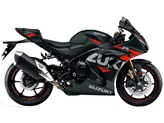Yamaha R1 2015 vs. Suzuki GSX-R 1000 2017

Yamaha R1 2015

Suzuki GSX-R 1000 2017
Vue d’ensemble - Yamaha R1 2015 vs Suzuki GSX-R 1000 2017
The Yamaha R1 2015 and the Suzuki GSX-R 1000 2017 are both powerful and high-performance supersport motorcycles. Let's compare their technical specifications and strengths and weaknesses.
In terms of engine and drive train, the Yamaha R1 2015 has a bore of 79 mm and a stroke of 50.9 mm, while the Suzuki GSX-R 1000 2017 has a bore of 76 mm and a stroke of 55.1 mm. The Yamaha R1 has an engine power of 200 HP and a torque of 112.4 Nm, while the Suzuki GSX-R 1000 has a slightly higher engine power of 202 HP and a torque of 118 Nm. Both bikes have a compression ratio of around 13 and are equipped with a 4-cylinder DOHC engine. The Yamaha R1 has a displacement of 998 ccm, while the Suzuki GSX-R 1000 has a displacement of 999 ccm.
In terms of suspension, both bikes feature upside-down telescopic forks at the front. The chassis of both bikes is made of aluminum, providing a lightweight and rigid structure. The Yamaha R1 has a Deltabox frame, while the Suzuki GSX-R 1000 has a Twin Tube, Twin-Spar frame.

Yamaha R1 2015
Both bikes have double disk brakes at the front, ensuring excellent stopping power. The Yamaha R1 is equipped with advanced rider assistance systems such as launch control and traction control. On the other hand, the Suzuki GSX-R 1000 comes with additional advanced rider assistance systems including ABS, riding modes, ride by wire, and traction control.
In terms of dimensions and weights, both bikes have a front tire width of 120 mm and a rear tire width of 190 mm, with a diameter of 17 inches for both front and rear tires. The Yamaha R1 has a wheelbase of 1405 mm, while the Suzuki GSX-R 1000 has a slightly longer wheelbase of 1410 mm. The seat height of the Yamaha R1 is 855 mm, while the Suzuki GSX-R 1000 has a slightly lower seat height of 825 mm. The kerb weight of the Yamaha R1 is 199 kg, while the Suzuki GSX-R 1000 is slightly heavier at 202 kg. Both bikes have a fuel tank capacity of around 17 liters, with the Suzuki GSX-R 1000 having a slightly larger capacity of 17.5 liters.
Now let's discuss the strengths and weaknesses of each bike. The Yamaha R1 2015 is known for its crazy sound and rev-happy engine with a strong peak. It provides a great racing feeling in the saddle and has a superior electronics package. The high-quality workmanship of the Yamaha R1 is also worth mentioning.

Suzuki GSX-R 1000 2017
On the other hand, the Suzuki GSX-R 1000 2017 is praised for its high-revving engine and a torque curve without any dents. It is super stable on corner exit and radius, making it a great choice for fast tracks. The bike also features a great quickshifter and a high-quality chassis.
However, the Yamaha R1 2015 does have some weaknesses. It experiences torque sag in the middle and lacks stability in the braking zone. On the other hand, the Suzuki GSX-R 1000 2017 has a weakness in that its engine brake is not adjustable.
In conclusion, both the Yamaha R1 2015 and the Suzuki GSX-R 1000 2017 are powerful and high-performance supersport motorcycles. They have their own strengths and weaknesses, and the choice between them ultimately depends on the rider's preferences and priorities.
Caractéristiques techniques Yamaha R1 2015 par rapport à Suzuki GSX-R 1000 2017
Avantages et inconvénients en comparaison
Avantages et inconvénients en comparaison
Yamaha R1 2015

La nouvelle R1 est une grande réussite et n'a plus rien à voir avec le modèle précédent. Celle-ci était considérée comme une bonne moto de campagne et il fallait investir lourdement pour les excursions sur les pistes de course. Aujourd'hui, c'est l'inverse. La nouvelle R1 a été développée en mettant clairement l'accent sur les pistes de course. Le package électronique semble exceptionnel, les technophiles y trouveront leur compte. Les fans de Yamaha ne peuvent que sauter sur l'occasion, ils ont enfin une moto digne de ce nom. La R1 présente de légères faiblesses au freinage sur piste, où elle devient un peu instable. Ceux qui aiment acheter une moto de course prête à l'emploi, sans devoir travailler sur le châssis, ont intérêt à choisir la R1M. La suspension électronique d'Öhlins fonctionne à merveille et ne présente aucune faiblesse. Pour une utilisation purement sur circuit, il est également facile de corriger la deuxième faiblesse de la R1. Le trou de couple au milieu peut être facilement comblé par une nouvelle cartographie.
Suzuki GSX-R 1000 2017

Suzuki a réussi à rendre la GSX-R 1000 2017 géniale. Une moto puissante comme un ours avec une courbe de couple incroyablement douce. Incroyable avec 202 ch ! Le châssis est de grande qualité et l'électronique n'a pas de paillettes, mais elle offre des performances exceptionnelles.
Comparaison des prix Prix moyen du marché Yamaha R1 vs Suzuki GSX-R 1000
There are a few key differences between a Yamaha R1 2015 and a Suzuki GSX-R 1000 2017. It takes less time to sell a Yamaha R1 with 76 days compared to 121 days for a Suzuki GSX-R 1000. Since model year 2005 1000PS.de editors have written 80 reviews for the Yamaha R1 and 71 reviews for the Suzuki GSX-R 1000 since model year 2005. The first review for the Yamaha R1 was published on 4/28/2003 and now has more than 3,900 views. This compares to more than 7,100 views for the first review on Suzuki GSX-R 1000 published on 3/3/2004.



















